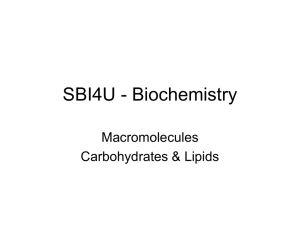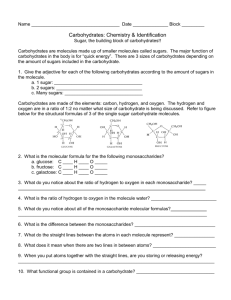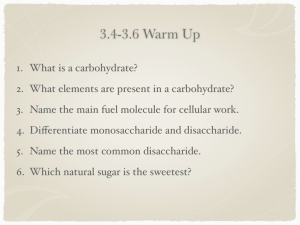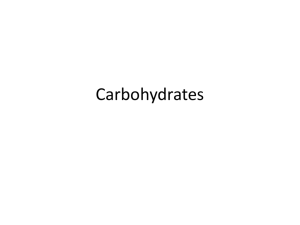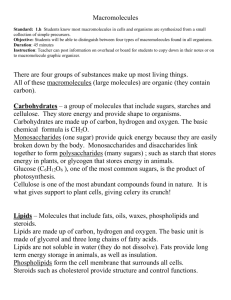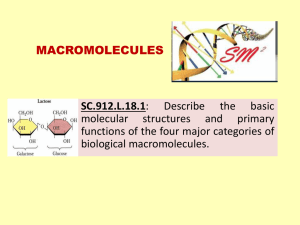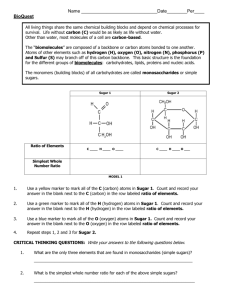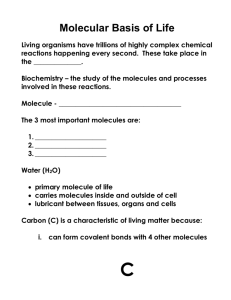Organic Chemistry
advertisement
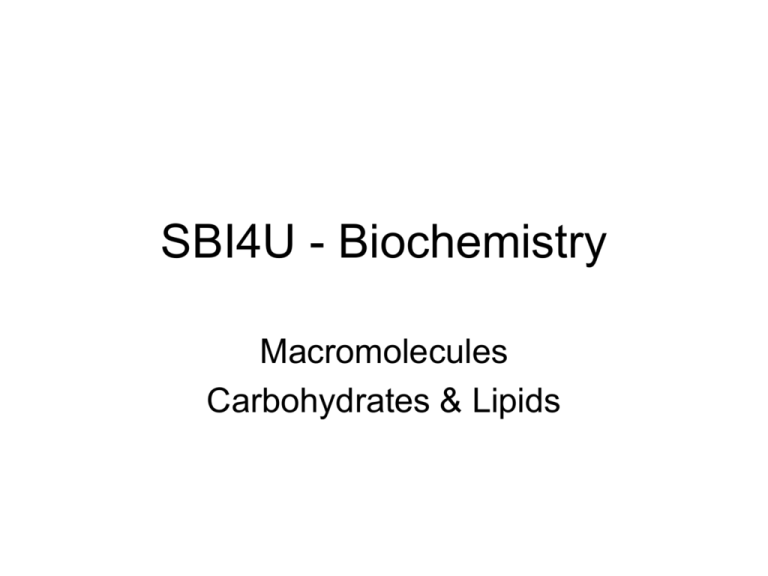
SBI4U - Biochemistry Macromolecules Carbohydrates & Lipids Organic Chemistry • originally the chemistry of compounds produced by living organisms • in general organic compounds contain carbon and hydrogen, and usually other elements such as nitrogen, sulfur and oxygen Macromolecules • macromolecules are large molecules that are often composed of repeating sub-units • some of the biologically important macromolecules are: – carbohydrates – proteins -lipids -nucleic acids Functional Groups • specific clusters of atoms attached to the carbon backbone • functional groups react in characteristic ways, giving chemical properties to macromolecules, and are involved in most reactions in living organisms Functional Groups Image from: http://www.bothbrainsandbeauty.com/academic-discussions/chemistry-academicdiscussions/functional-groups-429 Electronegativity (Image from: http://www.britannica.com) Polar vs. Non-Polar • molecular polarity is determined by: – polarity of bonds within molecule – symmetry of molecular structure • polarity of molecules or functional groups determines characteristics such as solubility Carbohydrates Image from: http://www.lifetime-fitness.ca/pages/meet-our-trainers/trainer-tips--nutritional • carbohydrates are the most important energy source • animals cannot synthesize carbohydrates; they must be consumed in plant material Structure of Carbohydrates • carbohydrates are made up of either single sugar molecules, or chains of many single sugar molecules – monosaccharides – disaccharides – oligosaccharides – polysaccharides Monosaccharides Image from: http://www.phschool.com/science/biology_place/biocoach/bioprop/glucose.html • single sugars in straight chain or ring form • C:H:O usually in 1:2:1 ratio (glucose is C6H12O6) • examples: fructose, galactose, ribose, deoxyribose Monosaccharides Image from: http://course1.winona.edu/sberg/241f08/Lec-note/Biochem.htm • some monosaccharides are isomers, e.g., glucose, fructose, and galactose Find the sugars… Image from: http://amerthehammer.com/2010/12/04/understanding-ingredient-labels-todays-tip/ Disaccharides Image from: http://mansfield.osu.edu/~sabedon/biol1020.htm • sugar molecules made from 2 single sugars • formed by a dehydration synthesis (condensation) reaction • See animation: http://www.youtube.com/watch?v=UyDnn D3fMaU Polysaccharides • oligosaccharides are shorter-chain sugars with 3-10 single sugars • longer chain carbohydrates are called polysaccharides • examples: starch, cellulose, glycogen, chitin Polysaccharides Image from: http://www.yellowtang.org/chemistry.php Lipids Image from: http://www.herdaily.com/health/892/the-effects-of-food-additives-and-preservatives.html • 3 groups: – fats, oils, waxes – phospholipids – steroids • Functions: – energy storage – insulation – absorption of vitamins – raw materials Triglycerides Image from: http://homepage.smc.edu/wissmann_paul/anatomy2textbook/phospholipids.html • most common type of fat • glycerol + 3 fatty acid molecules • saturated and unsaturated fatty acid chains • See animation: http://www.youtube.com/watch?v=3xF_L K9pnL0 Phospholipids Image from: http://www.bioteach.ubc.ca/Bio-industry/Inex/ • key component of cell membranes • 1 glycerol + 2 fatty acid chains + 1 phosphate group • phosphate end is polar and watersoluble, fatty acid end is non-polar Phospholipids Image from: http://micro.magnet.fsu.edu/cells/plasmamembrane/plasmamembrane.html Waxes Image from: http://igiwax.com/wax-basics/overview/ • long-chain fatty acids linked to alcohols/carbon rings • suitable as waterproof coating for plant leaves, animal feathers, etc. Steroids (Sterols) Images from: http://en.wikipedia.org/wiki/File:Cholesterol_structure.png and http://commons.wikimedia.org/wiki/File:Testosterone_structure.png • carbon-based multiple-ring structure • used to make hormones such as estrogen and testosterone
